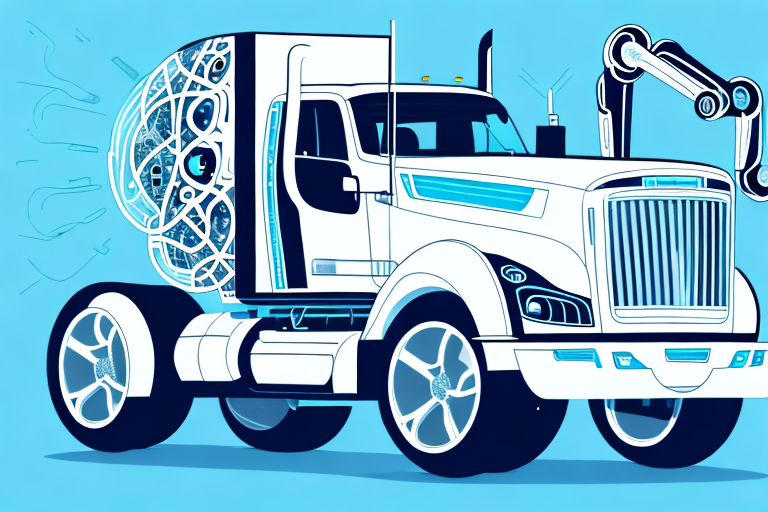Exploring Innovations in Logistics: How New Technologies are Revolutionizing the Industry
The logistics industry is undergoing a transformative phase, driven by the integration of cutting-edge technologies. From autonomous vehicles to blockchain, these innovations are redefining how goods are transported, tracked, and delivered. This article delves into some of the most impactful technologies shaping the future of logistics.
The Rise of Autonomous Vehicles in Logistics: Pros and Cons
Autonomous vehicles, including self-driving trucks and delivery vans, are at the forefront of logistics innovation. These vehicles promise to revolutionize the industry by significantly reducing transportation costs and delivery times. However, the adoption of this technology comes with its set of challenges.
Benefits of Autonomous Vehicles
- Increased Efficiency: Autonomous vehicles can operate 24/7 without the need for breaks, leading to faster delivery times and higher productivity.
- Reduced Fuel Consumption: Optimized driving patterns of autonomous vehicles contribute to lower fuel usage.
- Improved Road Safety: With advanced sensors and algorithms, these vehicles can potentially reduce accidents caused by human error.
Challenges and Considerations
- Safety Concerns: Ensuring the safety of autonomous vehicles in diverse driving conditions remains a significant hurdle.
- Regulatory Framework: Comprehensive regulations need to be established to govern the use of autonomous vehicles on public roads.
- Job Displacement: The rise of autonomous vehicles poses potential risks to employment for truck drivers and related professions.
Despite these challenges, the adoption rate of autonomous vehicles is steadily increasing. According to a Forbes report, several companies are actively testing self-driving trucks, indicating a promising shift towards wider implementation in the near future.
Big Data Analytics: A Game-Changer for Supply Chain Management
Big data analytics is revolutionizing supply chain management by enabling companies to derive actionable insights from vast amounts of data. This technology facilitates better decision-making, optimizing operations, and enhancing overall efficiency.
Predictive Demand Forecasting
By analyzing historical data and current market trends, big data analytics allows companies to accurately forecast demand. This predictive capability helps in optimizing inventory levels, thereby preventing stockouts and overstock situations.
Identifying Supply Chain Inefficiencies
Big data tools can pinpoint bottlenecks and inefficiencies within the supply chain. For example, analyzing transportation routes and delivery times can lead to the optimization of logistics processes, resulting in cost savings and improved service delivery.
According to a McKinsey & Company study, companies leveraging big data analytics have seen a 10-15% improvement in their supply chain efficiency.
Drones in Logistics: A Revolutionary Way to Deliver Goods
Drones are rapidly emerging as a viable solution for last-mile delivery in the logistics sector. Their ability to deliver small packages swiftly can significantly reduce delivery times and operational costs. However, widespread adoption requires overcoming certain obstacles.
Applications of Drones in Logistics
- Last-Mile Delivery: Drones can navigate traffic congestions and deliver packages directly to customers' doorsteps.
- Inventory Management: Equipped with sensors, drones can efficiently scan and manage inventory in large warehouses.
Challenges Facing Drone Integration
- Regulatory Hurdles: Airspace regulations need to be clearly defined to accommodate commercial drone operations.
- Battery Life and Weather Conditions: Limited battery life and adverse weather can restrict drone performance and reliability.
Major players like Amazon Prime Air and UPS are investing heavily in drone technology, signaling a strong future for drone-assisted logistics.
Blockchain Technology: Transforming the Way We Track and Trace Goods
Blockchain offers a secure and transparent method for tracking goods throughout the supply chain. Its decentralized nature ensures data integrity, reducing the risk of fraud and enhancing overall supply chain transparency.
Key Advantages of Blockchain in Logistics
- Enhanced Transparency: Every transaction is recorded on a public ledger, making it easy to track the movement of goods.
- Reduced Costs: Eliminating intermediaries streamlines processes and reduces transactional costs.
- Smart Contracts: Automated contracts can facilitate faster and error-free transactions.
Promoting Sustainability through Blockchain
Blockchain can aid in tracking the carbon footprint of goods, enabling companies to implement more sustainable practices. By providing visibility into each step of the supply chain, companies can identify and mitigate areas contributing to environmental impact.
A IBM report highlights how blockchain integration can lead to a more sustainable and efficient supply chain, aligning with global sustainability goals.
Internet of Things (IoT) in Logistics: Enhancing Efficiency and Transparency
The Internet of Things (IoT) enables real-time tracking and monitoring of assets, providing logistics companies with unprecedented visibility into their operations. IoT sensors placed on shipping containers, vehicles, and warehouses facilitate data collection and analysis, driving efficiency and transparency.
Optimizing Fleet Management
IoT devices can monitor vehicle performance, track location, and provide maintenance alerts. This leads to optimized fleet utilization, reduced downtime, and lower operational costs.
Improving Supply Chain Transparency
Real-time data from IoT sensors allows for better tracking of goods, ensuring timely deliveries and reducing the risk of theft or loss.
According to a Gartner report, IoT is set to enhance supply chain visibility, leading to a 20% increase in operational efficiency by 2025.
Artificial Intelligence (AI) in Warehousing: A Smarter Inventory Management System
Artificial Intelligence (AI) is revolutionizing inventory management by enabling predictive analytics and automation. AI-driven systems can forecast demand, optimize inventory levels, and streamline warehouse operations, leading to significant efficiency gains.
Predictive Analytics for Demand Forecasting
AI algorithms analyze historical sales data and market trends to accurately predict future demand. This enables businesses to maintain optimal inventory levels, reducing the risk of stockouts and overstocking.
Automation and Robotics
AI-powered robots can handle repetitive tasks such as picking, packing, and sorting, freeing up human workers to focus on more complex activities. This not only enhances productivity but also minimizes human errors.
A Forbes article discusses how AI integration in warehouses can lead to a 30% increase in operational efficiency and a significant reduction in operational costs.
Augmented Reality (AR) in Logistics: Improving Warehouse Operations
Augmented Reality (AR) technology is enhancing warehouse operations by providing workers with real-time information and guidance. By overlaying digital information onto the physical environment, AR improves accuracy and efficiency in various warehouse tasks.
Enhanced Navigation and Picking
AR glasses can guide workers through the warehouse, highlighting the most efficient routes and accurately locating items for picking. This reduces the time spent searching for products and minimizes errors.
Training and Safety
AR can be used to train new employees by simulating real-world scenarios, ensuring they are well-prepared before handling actual tasks. Additionally, AR can provide safety alerts and instructions, reducing the risk of workplace accidents.
According to a McKinsey report, warehouses implementing AR technology have seen a 25% improvement in picking accuracy and a 15% increase in overall efficiency.
Robotics in Logistics: The Future of Warehouse Automation
Robotics is playing a pivotal role in automating warehouse operations, leading to increased efficiency and reduced labor costs. Advanced robots are capable of performing tasks such as sorting, packing, and transporting goods with high precision.
Types of Robotics in Logistics
- Automated Guided Vehicles (AGVs): These robots transport goods within the warehouse, navigating predefined paths without human intervention.
- Collaborative Robots (Cobots): Designed to work alongside humans, cobots assist with tasks that require both precision and adaptability.
- Sorting Robots: These robots sort packages based on size, destination, and priority, streamlining the distribution process.
Benefits of Warehouse Robotics
- Increased Efficiency: Robots can operate continuously without breaks, significantly boosting productivity.
- Enhanced Accuracy: Automation reduces the likelihood of human errors in order fulfillment.
- Cost Savings: Although the initial investment is high, robotics can lead to long-term savings by reducing labor costs and improving operational efficiency.
Research from the Supply Chain Digital highlights that warehouses utilizing robotics have experienced a 40% increase in order processing speed and a 35% reduction in operational costs.
Cloud Computing in Logistics: Streamlining the Supply Chain
Cloud computing offers scalable and flexible solutions for managing supply chain operations. By leveraging cloud-based platforms, logistics companies can enhance collaboration, improve data accessibility, and streamline their processes.
Key Advantages of Cloud Computing
- Scalability: Cloud services can be easily scaled up or down based on demand, allowing businesses to adapt quickly to changes.
- Cost Efficiency: Reduces the need for substantial upfront investments in IT infrastructure, lowering capital expenditures.
- Enhanced Collaboration: Cloud platforms facilitate seamless communication and data sharing among supply chain partners.
Real-Time Data Access and Management
Cloud-based systems provide real-time access to data, enabling logistics companies to monitor and manage their operations more effectively. This real-time visibility aids in making informed decisions, optimizing routes, and improving inventory management.
A Forbes analysis indicates that logistics companies adopting cloud computing have reported a 20% improvement in operational efficiency and a 15% reduction in IT costs.
Cybersecurity Challenges for the Logistics Industry with the Adoption of New Technologies
The integration of advanced technologies in logistics has amplified the sector's vulnerability to cyber threats. As logistics systems become more interconnected, the risk of cyberattacks targeting sensitive data and disrupting operations increases.
Common Cybersecurity Risks
- Data Breaches: Unauthorized access to sensitive information can lead to financial losses and damage to reputation.
- Ransomware Attacks: Cybercriminals can encrypt critical data, demanding ransom for its release.
- Supply Chain Attacks: Targeting third-party suppliers to infiltrate the main supply chain network.
Mitigation Strategies
- Encryption: Protecting data through robust encryption techniques to prevent unauthorized access.
- Firewalls and Intrusion Detection Systems: Implementing advanced security measures to monitor and defend against potential threats.
- Regular Security Audits: Conducting frequent audits to identify and address vulnerabilities within the system.
A CSO Online article emphasizes the importance of proactive cybersecurity measures, noting that 60% of logistics companies plan to increase their cybersecurity budgets in the next fiscal year to combat rising threats.
Reducing Environmental Impact with Sustainable Logistics Practices and Technologies
The logistics industry is a significant contributor to environmental pollution, with transportation being a major source of carbon emissions. To mitigate their environmental impact, logistics companies are adopting sustainable practices and leveraging green technologies.
Sustainable Practices in Logistics
- Route Optimization: Utilizing software to plan the most efficient delivery routes, reducing fuel consumption and emissions.
- Packaging Reduction: Minimizing packaging materials to decrease waste and improve sustainability.
- Electric Vehicles: Transitioning to electric trucks and vans to lower carbon footprints.
Green Technologies Enhancing Sustainability
- Renewable Energy Sources: Implementing solar and wind energy solutions in warehouses and distribution centers.
- Energy-Efficient Warehousing: Utilizing smart lighting and climate control systems to reduce energy usage.
- Carbon Tracking Systems: Monitoring and managing carbon emissions across the supply chain.
A Environmental Leader report highlights that sustainable logistics practices have led to a 25% reduction in greenhouse gas emissions for companies that have fully integrated green technologies into their operations.
In conclusion, the logistics industry is at the cusp of a technological revolution, with innovations like autonomous vehicles, blockchain, and IoT driving significant improvements in efficiency and transparency. While these advancements present challenges related to safety, security, and employment, they also offer opportunities for enhanced operational performance and sustainability. As the industry continues to embrace these technologies, it is imperative to address the ethical and environmental implications to ensure a sustainable and resilient future.




















